So imagine this scenario: piping hot coffee on your desk, paperwork and pens strewn across your table, you sit in your swivel office chair and your hands eagerly move towards your keyboard. All of a sudden, your coffee has turned cold, fearful symptoms of repetitive strain injury start to show, four hours have passed and you realized you have not moved an inch away from your workstation. I assume there are some head nodding and sighs of agreement as you recall the last time this happened to you. It is easy to forget the amount of time you spend using your electronics, especially when you are knee deep in your work. Prolonged sitting for hours on end can lead to detrimental health risks like cardiovascular diseases and type 2 diabetes, as well as decreases in productivity and overall mood. However, if you are aware of the risks, and want to get up regularly, it can be easy to forget.
Fortunately, there are many solutions available that can give that gentle nudge or prompt to change posture and ensure you move more when you work. For me personally, I have never relied on apps to keep myself accountable and struggle with allocating myself appropriate break times thus suffering from eye strain and fatigue at the end of the day. Therefore I decided to do a little experiment. I compiled a list of apps to try out on both my MacBook and my iPhone for a week. I tested each app for two days each. Check out the results below.
For MacBooks:
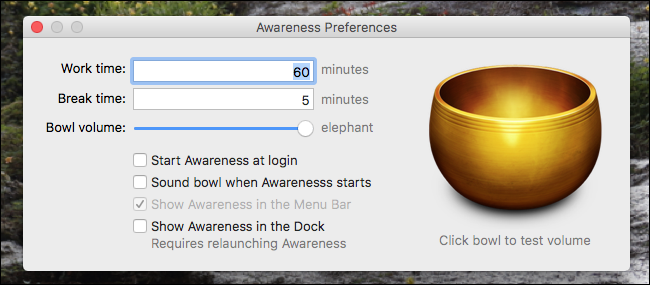 Awareness: Awareness is an app that allows users to set a timer that tracks the amount of activity on your computer. You will be able to input your work time and break time period in minutes. After your set work time, a subtle sound notification in the form of a Tibetan singing bowl will remind you that it’s time to take a break. Instead of an intrusive break reminder, this app uses a more minimal and a less in-your-face approach. Available for both Windows and MacOS users, it is easy to navigate and it is perfect for people who can’t stand annoying interruptions.
Awareness: Awareness is an app that allows users to set a timer that tracks the amount of activity on your computer. You will be able to input your work time and break time period in minutes. After your set work time, a subtle sound notification in the form of a Tibetan singing bowl will remind you that it’s time to take a break. Instead of an intrusive break reminder, this app uses a more minimal and a less in-your-face approach. Available for both Windows and MacOS users, it is easy to navigate and it is perfect for people who can’t stand annoying interruptions.
Rating: 4.5/5. I enjoyed this one a lot as I am the type of person who doesn’t like interruptions and enjoys doing work without any obstructions.
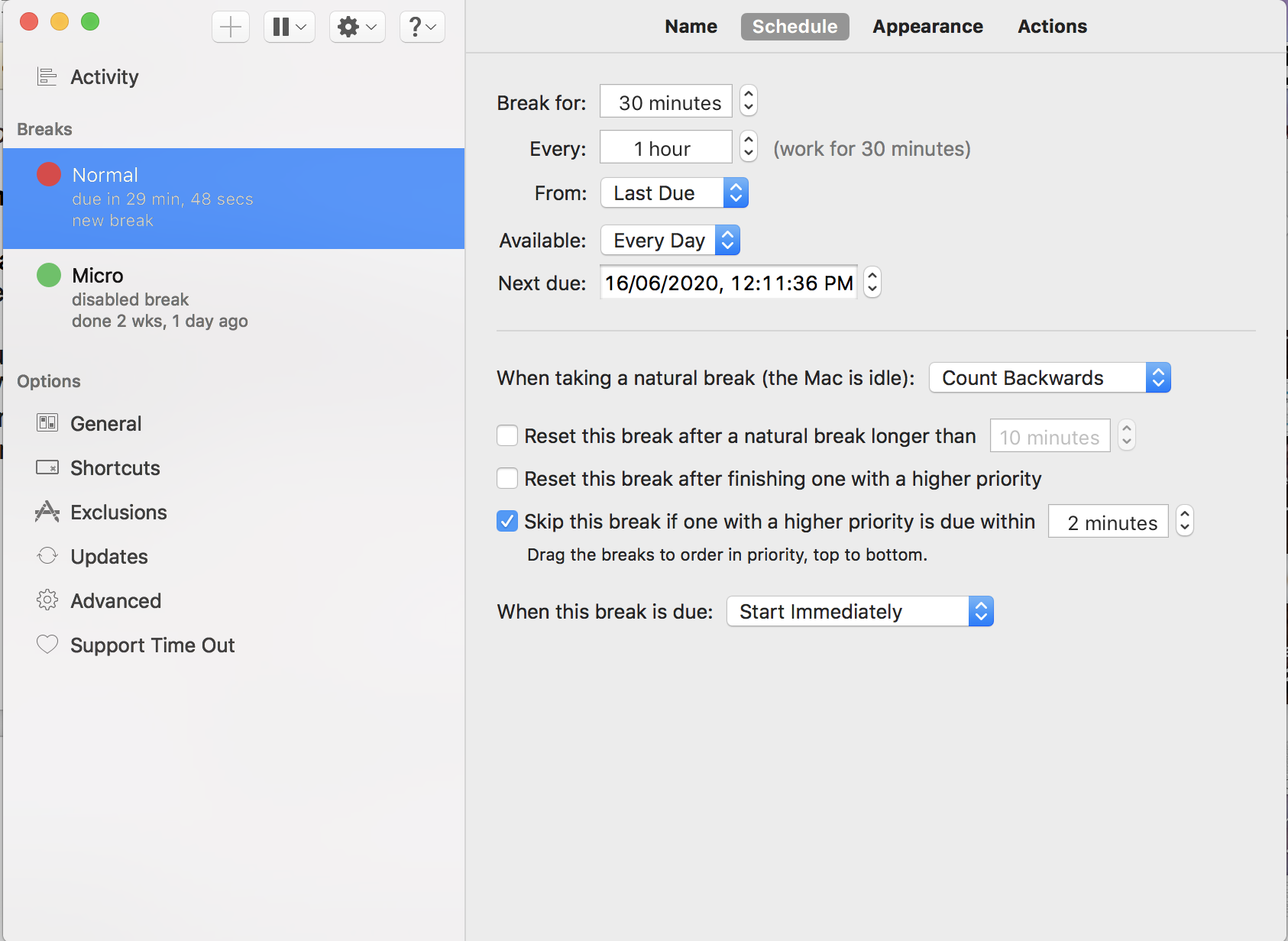 Time out: Time out allows you to set two kind of breaks: a “Normal” break, typically for 10 minutes every hour, so you can move about and relax; a “Micro” break: a very brief pause of typically 15 seconds every 15 minutes, so you can remember not to tense up too much for long periods. Both breaks can be changed or disabled if desired. When it’s time to stop looking at your computer screen, Time Out will fade the screen display, dimming your screen and pulling up a progress bar that shows the remainder of your break time.
Time out: Time out allows you to set two kind of breaks: a “Normal” break, typically for 10 minutes every hour, so you can move about and relax; a “Micro” break: a very brief pause of typically 15 seconds every 15 minutes, so you can remember not to tense up too much for long periods. Both breaks can be changed or disabled if desired. When it’s time to stop looking at your computer screen, Time Out will fade the screen display, dimming your screen and pulling up a progress bar that shows the remainder of your break time.
Rating: 3.5/5. I found this app a little annoying because if you’re in the middle of a task, it’s troublesome to keep postponing or skipping a break. The fade screen disrupts my concentration and I didn’t really enjoy this app as much as the others. However I did really enjoy having micro and normal breaks.
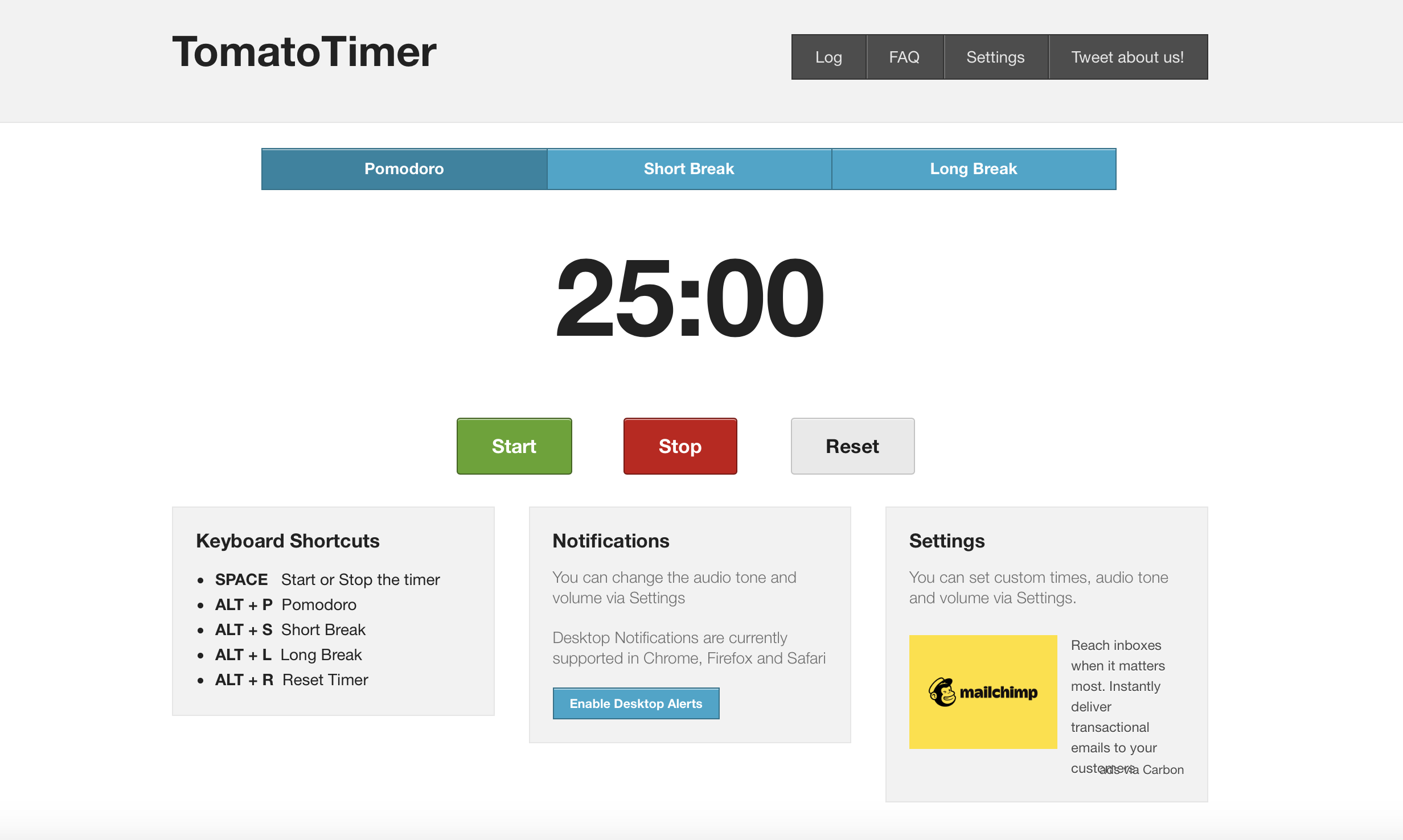 Tomato timer: The Pomodoro method is a simple process for time management that has proven to boost productivity. The tomato timer actually is a website that even non-Mac users can use. It is a simple page that you can practice the Pomodoro method easily as there are only a start, stop and reset button present. So you click start on the 25 minute timer and when it is up, a beeping alarm sound will go off, urging you to click the stop and reset button. It is easy to navigate and pull up to use, plus I find the Pomodoro method to be extremely useful, so it was nice to have an app that already has everything laid out for you to use.
Tomato timer: The Pomodoro method is a simple process for time management that has proven to boost productivity. The tomato timer actually is a website that even non-Mac users can use. It is a simple page that you can practice the Pomodoro method easily as there are only a start, stop and reset button present. So you click start on the 25 minute timer and when it is up, a beeping alarm sound will go off, urging you to click the stop and reset button. It is easy to navigate and pull up to use, plus I find the Pomodoro method to be extremely useful, so it was nice to have an app that already has everything laid out for you to use.
Rating: 4/5. It is easy to navigate and pull up to use, plus I found the Pomodoro method to be extremely useful, so it was nice to have an app that already has everything laid out for you to use.
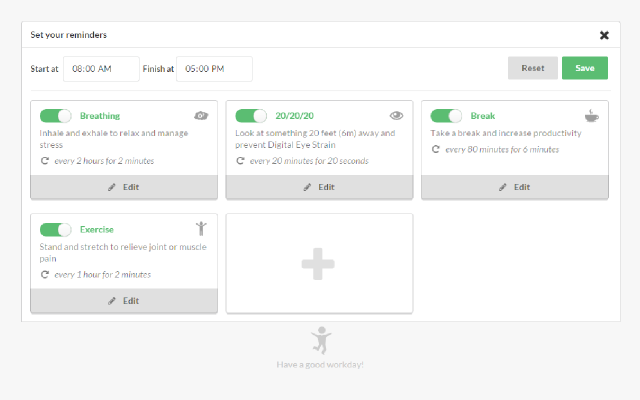 Micro breaks extension on Chrome: If you use Google chrome, this customizable reminder app is very useful for multiple break reminders. You can set multiple notifications and assign alarm times for each. All notifications are customizable but by default, there are some helpful reminders set for healthy habits, for example:
Micro breaks extension on Chrome: If you use Google chrome, this customizable reminder app is very useful for multiple break reminders. You can set multiple notifications and assign alarm times for each. All notifications are customizable but by default, there are some helpful reminders set for healthy habits, for example:
- Breathing: Breathe in and out to manage stress, for 2 minutes, every 2 hours.
- 20/20/20: Prevent digital eye strain by looking at something 20 feet away, for 20 seconds, every 20 minutes.
- Break: A simple break, for 6 minutes, every 80 minutes.
- Exercise: Stand up and stretch to relieve muscles, for 2 minutes, every hour.
Rating: 3.5/5. I enjoyed this app a lot as it lets you customise your reminders and it gives a bit more info and structure about your day. It’s a very non-obtrusive app but the only major problem is that it doesn’t provide sound notifications.
For iPhones
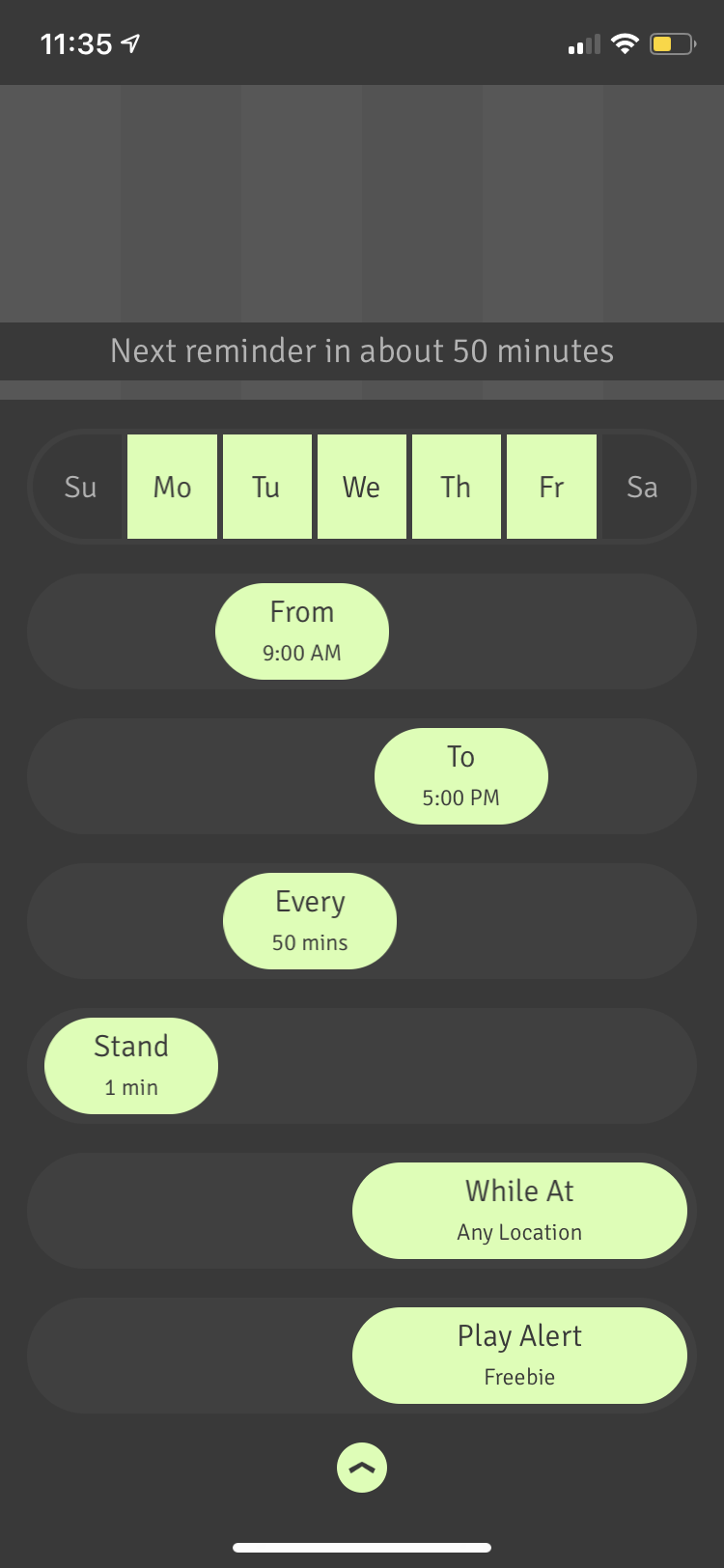 Stand up! The work time breaker: A free app that allows you to set your break intervals throughout your day according to your work schedule. It allows full customization from when your work starts, ends, break times and stand timers. Besides that, it also allows you to customize in which location you are able to use this app (based on location services settings). However, I would like to point out that the alarm for this app only goes off once, so if you miss it (which I did a couple of times and never even noticed), it won’t remind you that you have missed a break. ,
Stand up! The work time breaker: A free app that allows you to set your break intervals throughout your day according to your work schedule. It allows full customization from when your work starts, ends, break times and stand timers. Besides that, it also allows you to customize in which location you are able to use this app (based on location services settings). However, I would like to point out that the alarm for this app only goes off once, so if you miss it (which I did a couple of times and never even noticed), it won’t remind you that you have missed a break. ,
Rating: 3.5/5. It wasn’t the best, but it wasn’t the worst either. There wasn’t anything special about this app besides it’s attractive visuals.
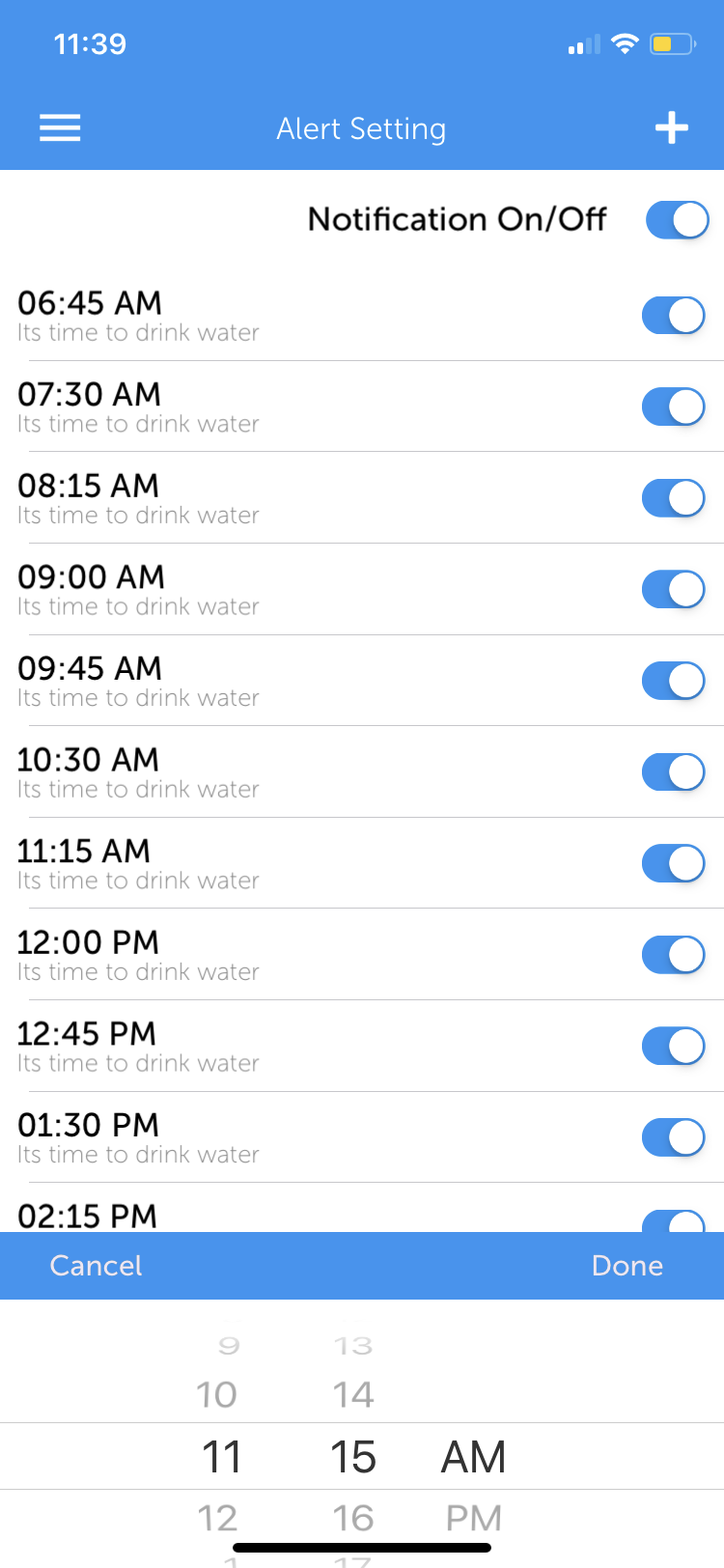 Drink water reminder: This app that notifies and reminds you to drink water whenever needed. I found this app to be rather useful as I am able to use those reminders as a short break interval too, plus I get to drink more water (which admittedly I do neglect when I’m knee deep in work). It is a simple app with attractive graphic displays to demonstrate your hydration level and daily consumption.
Drink water reminder: This app that notifies and reminds you to drink water whenever needed. I found this app to be rather useful as I am able to use those reminders as a short break interval too, plus I get to drink more water (which admittedly I do neglect when I’m knee deep in work). It is a simple app with attractive graphic displays to demonstrate your hydration level and daily consumption.
Rating: 4/5. I thoroughly enjoyed this app as it was really easy to use and it prevents me from feeling dehydrated throughout the day.
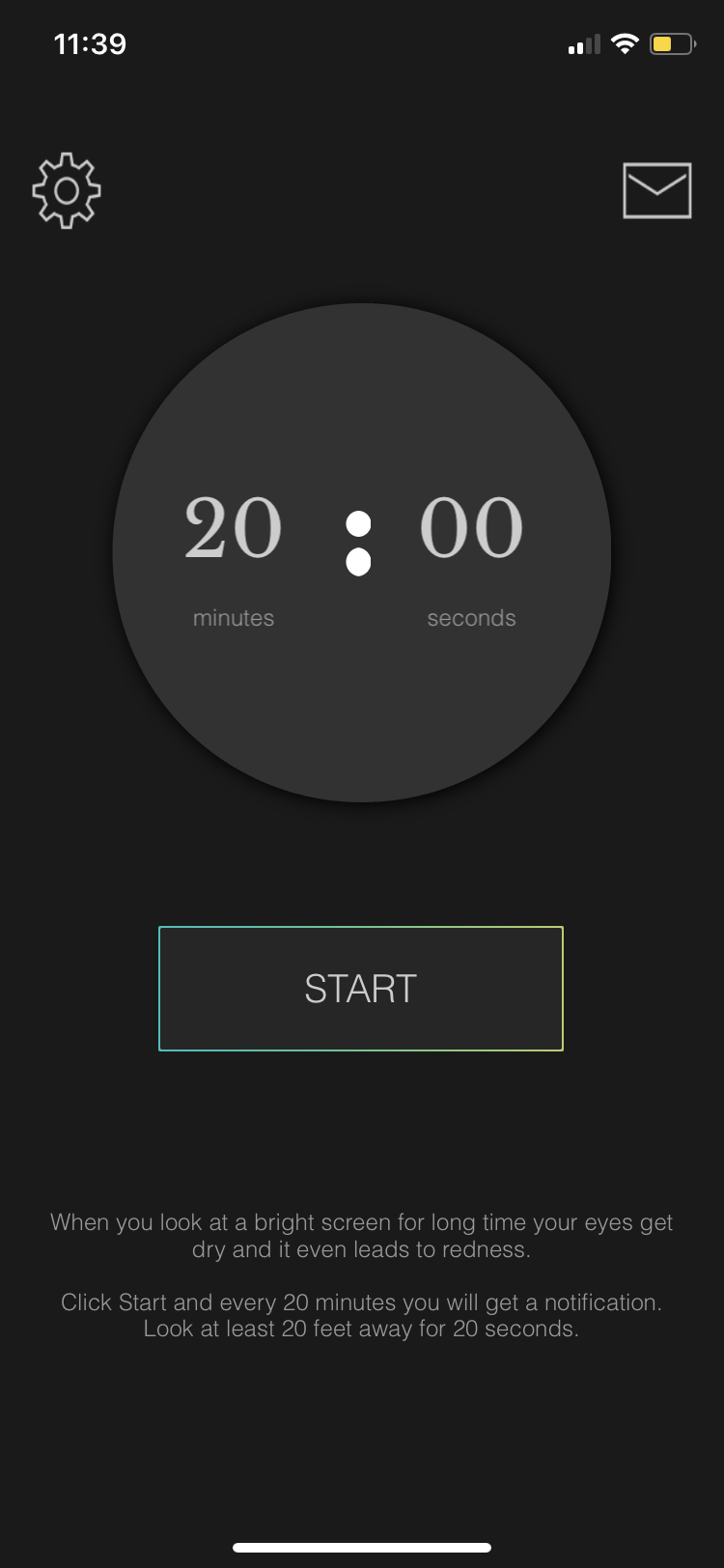 Eye care 2020: Eye care 2020 is a mobile app to relieve this eye strain using an age-old technique- The 20-20-20 rule. This rule suggests that after every 20 minutes, the user should take a break for at least 20 seconds and look at objects that are 20 feet away. The app is simple to use, you just open the app and click start, you can just leave it be and it will notify your every 20 minutes (even if you close the app). By that, it isn’t reliant on whether the screen has been on for all of those 20 minutes or not, that reminder is coming.
Eye care 2020: Eye care 2020 is a mobile app to relieve this eye strain using an age-old technique- The 20-20-20 rule. This rule suggests that after every 20 minutes, the user should take a break for at least 20 seconds and look at objects that are 20 feet away. The app is simple to use, you just open the app and click start, you can just leave it be and it will notify your every 20 minutes (even if you close the app). By that, it isn’t reliant on whether the screen has been on for all of those 20 minutes or not, that reminder is coming.
Rating: 3/5. I found the app to be quite persistent with their reminders, and I didn’t really enjoy the 20-20-20 method as I prefer longer work times and shorter break times.
Unhook: This last one is an app that unfortunately wasn’t available on the App Store as it was made for Android phones. Even-though I couldn’t try it out, this app intrigued me a lot based on the reviews I’ve been seeing online. Basically it doesn’t give you reminders to take breaks, but instead, it forces breaks upon you. So here’s how it works. You set a daily time limit for different types of screen usage, such as social media apps, video streaming, and games. Then once you cross the limit you set, Unhook makes you walk to unlock more time. For every 100 steps that you walk, you will get 10 minutes of extra usage time on the phone. The data is gathered through the built-in Google Fit on Android. I would say it is a very intrusive and strict app, but then again it does keep you accountable as compared to all the previous apps I’ve reviewed.
Summary: All in all, each app had their own pros and cons. I find it helpful to try them out till you find one that suits your work ethics, schedule and break preference the most.
This post, and the research for this post, was conducted by Jade Lim
![]()

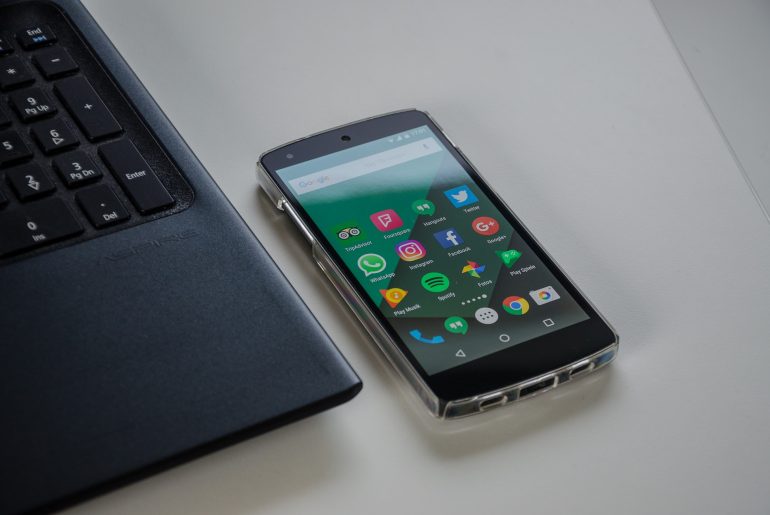





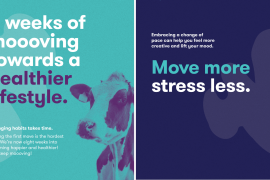


Comments are closed.